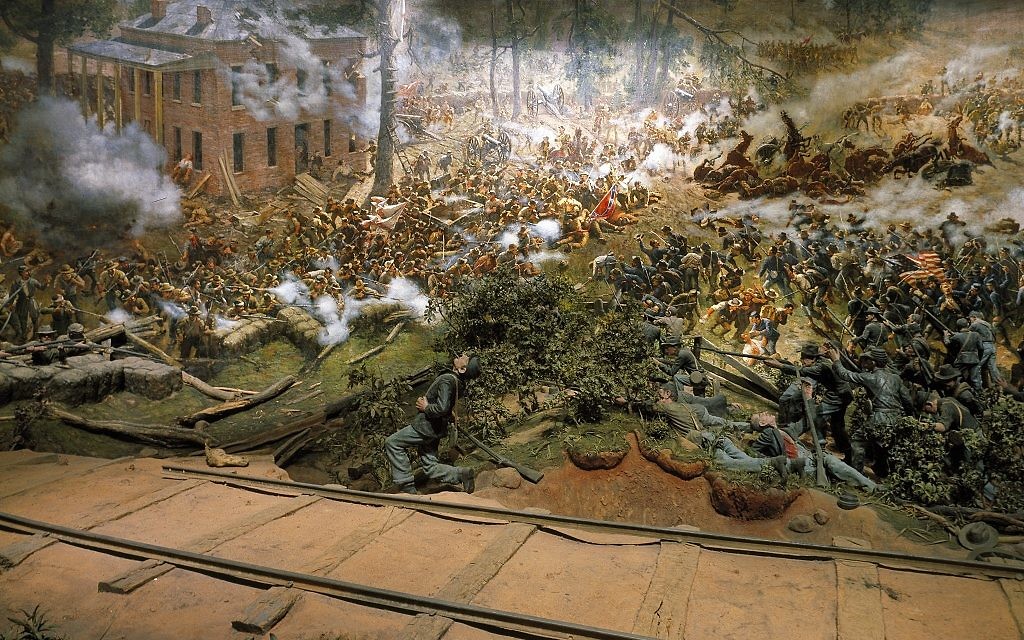Visiting the Cyclorama
The Cyclorama, which depicts a significant moment in Atlanta history should be seen in all its glory.
When I read on the front page of The New York Times here in Jerusalem about the move of cyclorama painting of the Battle of Atlanta from Grant Park to the Atlanta History Center, I realized how meaningful it was that this great painting depicting a significant moment in Atlanta history was being transferred to a locale where it could be seen in all its glory.
In the fall of 1946, after my father, Louis Geffen, returned from serving six years in the Army during World War II, he took me to see the circular painting depicting the 1864 battle. A few Confederate war veterans were still alive, and one of them described the battle as shown in the painting, the work of artists from Milwaukee.
George Gress, a rich Atlanta lumber merchant, had bought the painting, which in 1889 was placed in a wooden building at Grant Park (named after railroad entrepreneur Lemuel Grant, who donated the land to the city in 1885).
Get The AJT Newsletter by email and never miss our top stories Free Sign Up
The excitement of the painting had several elements to it. One was to see an actual Civil War battle happening. Later, I learned from Martha Barnes, who taught the required Atlanta history class at Grady High School, the important role our city played in the terrible, internecine conflict.
On that first visit, my father told me how he and his brothers and friends between 1910 and 1917 dug up Minie balls left from the battle. They were resting in the dirt near their home on Hunter Street (MLK Drive).
Another fascination for me was the manner in which the Confederate veteran described each element of the battle as both sides, Yankees and rebels, fought to the death. I remember him naming the commanders with whom he was familiar, and I recall his description of a bird flying in the painting as the battle rages in the city below him.
This was the first painting I had ever seen, and it was circular. When I later saw paintings that were flat, I always treasured my visits to the cyclorama. From 1946 to the late 1950s, I visited the painting 10 times. After my mother took me to see “Gone With the Wind” at the Empire Theater during its first rerelease, I appreciated the cyclorama even more.
My family had its own connection with Grant Park and the Cyclorama, as I am sure many other families did. My great-grandfather Yosef Geffen was a lumber broker in Lithuania. He bought trees in Lithuanian forests that were cut and shipped to Germany.
He told stories to his children, as Rav Tuvia Geffen records in his autobiography, about his years as a youngster when his family lived in a small shtetl and he had to walk through the forests each day to get to the yeshiva ketana (pre-yeshiva) where he studied.
So his son Rabbi Geffen had an interest in forests that developed into his love for Grant Park when the Geffens reached Atlanta in 1910. Back then, Grant Park had the largest concentration of trees in the city. The family lived on Hunter Street, as many Jews did, so the park was close by.
Many Atlanta Jewish organizations held outdoor races, barbecues, canoe races in the lake, fashion shows and other types of activities. Piedmont Park also was used, but Grant Park was considered more heimish.
A recollection from my father: “After we moved to Atlanta and settled in to the community, my father, Rav Tuvia, began to investigate the neighborhoods around us as well as Grant Park and Piedmont Park. He described to us what a beautiful city Atlanta was and what afforestation it contained. In the summer of 1911 four of us, myself, Lottie, Joel and Sam, began our Shabbat walks in Grant Park. Our father would explain the different trees which he knew, learned both from Yiddish books and from tree books. His enthusiasm excited us but most of all made us feel like real Atlantans. I have always treasured those walks.”
They also learned about the painting of the Battle of Atlanta, a historical event that was very much alive in the years before World War I. So it was natural for my father to take me to Grant Park and the cyclorama first. My recollections of the park and the painting are always with me.
I hope you will go to the Atlanta History Center to see it restored.





comments